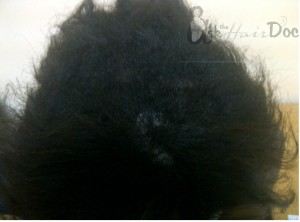
Dear Doc,
I just had a baby boy and I got the same hair loss that I had after my first pregnancy. I expected that, but this time I noticed that my hair did not grow back the same way. It looks thinner in the front. What’s up with that? What can I do to stop this?
Concerned Mama

Dear Concerned Mama,
Congrats on your second child!
Yes you have experienced the typical Postpartum hair shedding also known as Telogen Effluvium. During your pregnancy almost all of your hairs are in the anagen (growing) stage of hair growth. This is due to the high levels of the hormone oestrogen in the body which is known to keep the hair in the growing stage longer. As soon as your hormone levels go back to normal after delivering your baby boy, your hair follicles converted back to the regular 90% anagen :10% telogen. The telogen stage is the resting stage, the stage right before the hair falls out. What happens in some women is that this shedding can reveal latent or hidden Female Pattern Hair Loss (1) resulting in decreased density in their hair at the front of your scalp right behind their hairline. Some of their hairs have grown back in smaller, finer and thinner. Their parts look much bigger than usual and they see more scalp. Look at your family members. Do all the men have hair? Do the women have thin hair as well? If so, this is unfortunately showing up in you as well.
So what can you do about this? If you’re not breastfeeding, you can try topical 2% or 5% Minoxidil (Rogaine is a brand) twice a day. It is available over the counter in a lot of countries. If after four to six months you do not see an improvement you may need to visit a doctor to see whether or not you may need oral medication to help slow down your hair loss.
(1) Birch, M. P., Lalla, S. C. and Messenger, A. G. (2002), Female pattern hair loss. Clinical and Experimental Dermatology, 27: 383–388. doi: 10.1046/j.1365-2230.2002.01085.x




